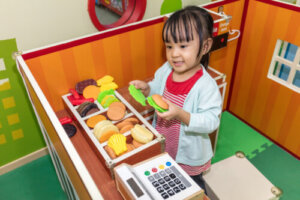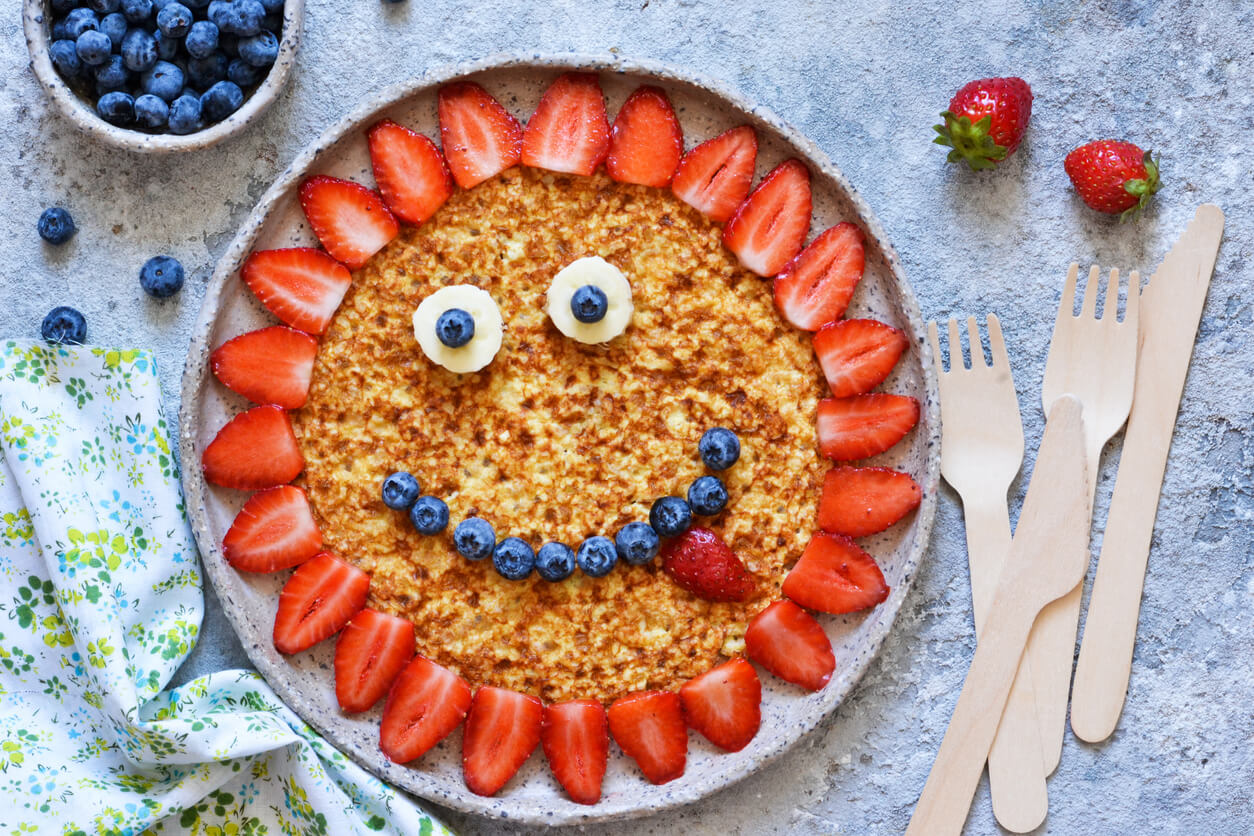4 Games to Work on Healthy Eating


Written and verified by the psychologist Maria Fátima Seppi Vinuales
Because it’s adults who are responsible for taking care of children’s food, this task is often reduced solely to their participation. However, allowing children to get involved in healthy eating through games is an excellent opportunity to start talking about eating habits, recommendations, and self-care guidelines. So, let’s look at some ideas to learn to eat better and do it while playing!
4 games to work on healthy eating
Here are some of the games for children to consider to work on healthy eating.
1. Teaching children to shop
Whether they really accompany us or we pretend to have a supermarket at home, this is one of the ways for little ones to learn to eat healthily. For example, we can tell them that we want to make a pot pie. Then, we make a shopping list with the name of the food and the amount we need for each item. Then, we give them money (you can use toy money or make your own) to make the purchase. In addition, we can exchange the roles of seller and customer and take advantage of the opportunity to ask them questions or provide them with information.
2. Cooking with children
Another way to promote healthy eating is to associate it with a fun plan, such as cooking together. This way, children can become kitchen helpers. This will be an ideal moment to talk about foods and their properties, explore their textures and flavors, or recognize their aromas and colors, among other things.

3. Preparing dishes in fun shapes
There are different molds that allow us to give different shapes to food. For example, we can present certain foods cut into squares, triangles, or hearts. Suddenly, our plate can become a work of art that kids will find fun and interesting and will encourage them to try it.
4. Create a food traffic light
A good idea can be to make a list of foods that kids should classify in the color of the corresponding traffic light according to how often we should eat them. Red means that their consumption should be avoided on a daily basis or should be done sparingly; green indicates that these foods should be included in our diet on a frequent basis; finally, yellow indicates that these foods should be present with some regularity.
You may be interested in: Great Healthy Snack Alternatives for Your Kids
Other recommendations on food
In addition to worrying about what’s served on the plate, we should also think of food as a ritual. Especially, you should keep in mind that it also has an important social and cultural component. For example, in many societies, offering a typical meal is a way of entertaining someone from another country. So, let’s also take a look at some food recommendations:
- Assure that mealtime doesn’t take place at the same time as other activities. The healthy aspect of eating not only has to do with rhythms, but also with the way we eat. It’s important that children can be aware of what they’re eating and enjoy the food.
- We may not always be able to prepare a game around food. Sometimes, in the midst of the daily schedule, there’s rush and hunger. However, we can set aside a day of the week to do so. At other times, when serving the food, we can tell the children why we chose that menu and what the characteristics that make it healthy are.
- Take into account the children’s ages to adapt the game. When little ones already know how to read or even when they’re teenagers, we can speak in other terms or use other resources. For example, we can encourage them to read product labels: What does saturated fat food mean, or recommend series, TikTok videos, books, or documentaries on the subject. You can also work on social issues such as the care that some people take with regard to certain foods (as in the case of celiac disease), among others.
You may be interested in: The Value of Discipline in Healthy Eating

Rethink our way of talking about food
Children are always a source of learning. This is because, when transmitting knowledge to them, we must also review some of our practices. In this regard, many times, although unintentionally, we transmit values and ideas regarding certain foods. This can lead us to create certain ideas in them and to condition their relationship with food.
For example, it’s common for adults to refer to the fact that we feel like eating “something fatty” when we crave some caloric food, such as a chocolate cake or a hamburger and fries. However, that expression is loaded with a negative appraisal of being fat or overweight. As a replacement, we can name the food in question or find a more accurate expression. Or, when we say that a food is bad or good, it’s best to appeal to say that it’s healthier or less healthy.
In turn, if we’re educators, we must always be very sensitive and tactful when teaching healthy eating habits. Sometimes, we may refer to a cultural or social custom in certain families as something negative. For example, when we say that some dish isn’t recommended for children then that food is, precisely, the one our grandmother cooks.
Because it’s adults who are responsible for taking care of children’s food, this task is often reduced solely to their participation. However, allowing children to get involved in healthy eating through games is an excellent opportunity to start talking about eating habits, recommendations, and self-care guidelines. So, let’s look at some ideas to learn to eat better and do it while playing!
4 games to work on healthy eating
Here are some of the games for children to consider to work on healthy eating.
1. Teaching children to shop
Whether they really accompany us or we pretend to have a supermarket at home, this is one of the ways for little ones to learn to eat healthily. For example, we can tell them that we want to make a pot pie. Then, we make a shopping list with the name of the food and the amount we need for each item. Then, we give them money (you can use toy money or make your own) to make the purchase. In addition, we can exchange the roles of seller and customer and take advantage of the opportunity to ask them questions or provide them with information.
2. Cooking with children
Another way to promote healthy eating is to associate it with a fun plan, such as cooking together. This way, children can become kitchen helpers. This will be an ideal moment to talk about foods and their properties, explore their textures and flavors, or recognize their aromas and colors, among other things.

3. Preparing dishes in fun shapes
There are different molds that allow us to give different shapes to food. For example, we can present certain foods cut into squares, triangles, or hearts. Suddenly, our plate can become a work of art that kids will find fun and interesting and will encourage them to try it.
4. Create a food traffic light
A good idea can be to make a list of foods that kids should classify in the color of the corresponding traffic light according to how often we should eat them. Red means that their consumption should be avoided on a daily basis or should be done sparingly; green indicates that these foods should be included in our diet on a frequent basis; finally, yellow indicates that these foods should be present with some regularity.
You may be interested in: Great Healthy Snack Alternatives for Your Kids
Other recommendations on food
In addition to worrying about what’s served on the plate, we should also think of food as a ritual. Especially, you should keep in mind that it also has an important social and cultural component. For example, in many societies, offering a typical meal is a way of entertaining someone from another country. So, let’s also take a look at some food recommendations:
- Assure that mealtime doesn’t take place at the same time as other activities. The healthy aspect of eating not only has to do with rhythms, but also with the way we eat. It’s important that children can be aware of what they’re eating and enjoy the food.
- We may not always be able to prepare a game around food. Sometimes, in the midst of the daily schedule, there’s rush and hunger. However, we can set aside a day of the week to do so. At other times, when serving the food, we can tell the children why we chose that menu and what the characteristics that make it healthy are.
- Take into account the children’s ages to adapt the game. When little ones already know how to read or even when they’re teenagers, we can speak in other terms or use other resources. For example, we can encourage them to read product labels: What does saturated fat food mean, or recommend series, TikTok videos, books, or documentaries on the subject. You can also work on social issues such as the care that some people take with regard to certain foods (as in the case of celiac disease), among others.
You may be interested in: The Value of Discipline in Healthy Eating

Rethink our way of talking about food
Children are always a source of learning. This is because, when transmitting knowledge to them, we must also review some of our practices. In this regard, many times, although unintentionally, we transmit values and ideas regarding certain foods. This can lead us to create certain ideas in them and to condition their relationship with food.
For example, it’s common for adults to refer to the fact that we feel like eating “something fatty” when we crave some caloric food, such as a chocolate cake or a hamburger and fries. However, that expression is loaded with a negative appraisal of being fat or overweight. As a replacement, we can name the food in question or find a more accurate expression. Or, when we say that a food is bad or good, it’s best to appeal to say that it’s healthier or less healthy.
In turn, if we’re educators, we must always be very sensitive and tactful when teaching healthy eating habits. Sometimes, we may refer to a cultural or social custom in certain families as something negative. For example, when we say that some dish isn’t recommended for children then that food is, precisely, the one our grandmother cooks.
All cited sources were thoroughly reviewed by our team to ensure their quality, reliability, currency, and validity. The bibliography of this article was considered reliable and of academic or scientific accuracy.
- Bolaño, M. A., & Martín, A. A. (1996). La prevencion como estrategia de abordaje en una enfermedad cronica: La enfermedad celiaca. Pediatrika, 16, 33-37.
- Calle, Irene de la, Ros, Gaspar, Peñalver, Rocío, & Nieto, Gema. (2020). Enfermedad celiaca: causas, patología y valoración nutricional de la dieta sin gluten. Revisión. Nutrición Hospitalaria, 37(5), 1043-1051. Epub 04 de enero de 2021.https://dx.doi.org/10.20960/nh.02913
This text is provided for informational purposes only and does not replace consultation with a professional. If in doubt, consult your specialist.








